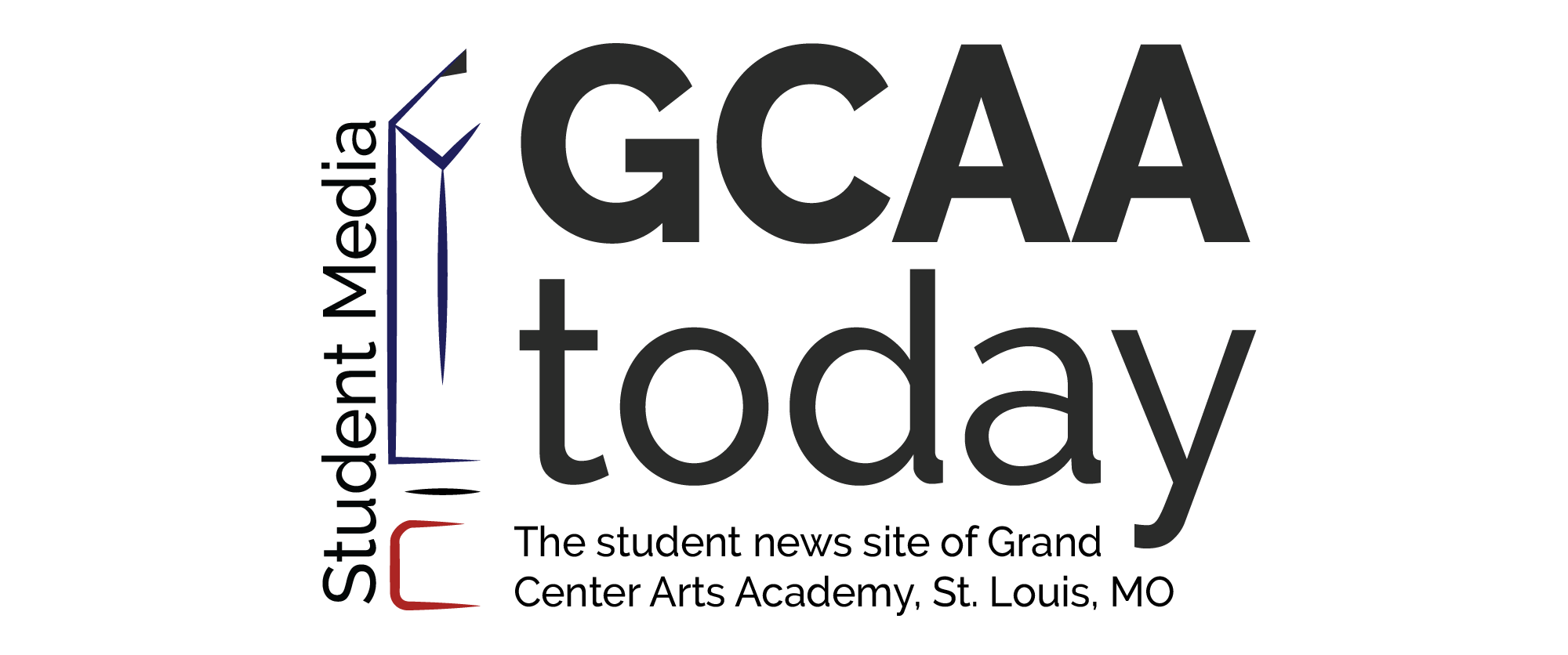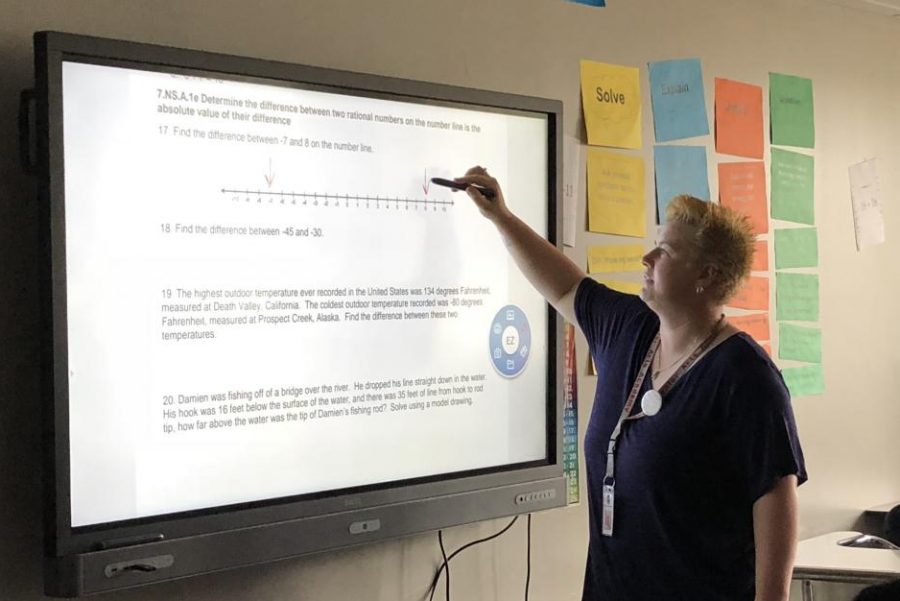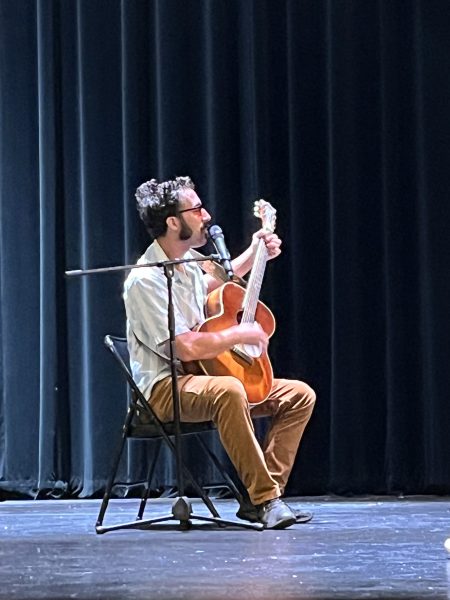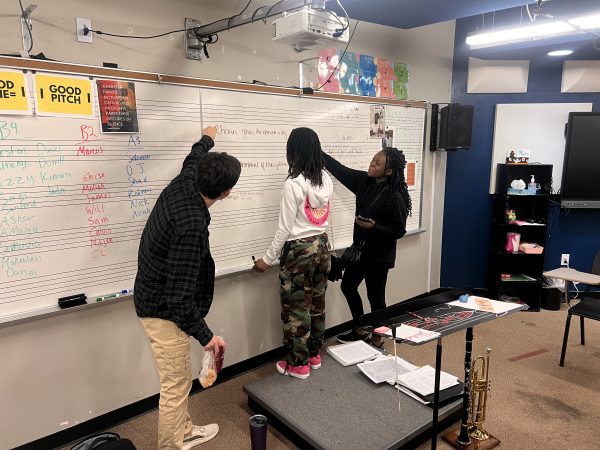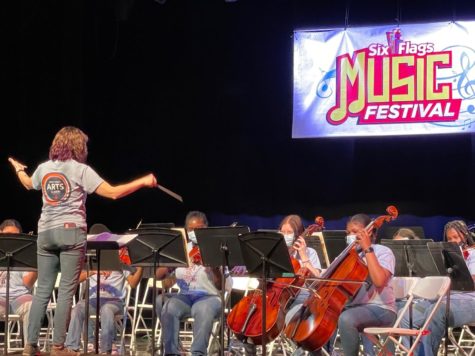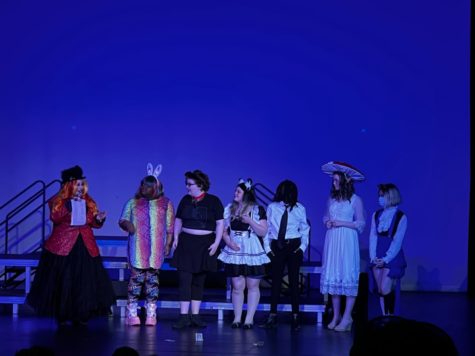New interactive boards added to select classrooms to enhance learning
Middle school math teacher Elisabeth Reeder demonstrates determining the difference between two rational numbers using the BenQ interactive board in her classroom. “I think it gets the students more engaged,” Reeder said. “It allows for different types of activities that you can’t really do if you just have the whiteboard.”
Within the past year, Confluence has been putting interactive boards, or BenQ’s, on a test run throughout all Confluence schools. Elisabeth Reeder, seventh grade math teacher at GCAA, was one of the recipients of the BenQ’s.
“It was a trial, so in Confluence, each building got one board in the whole building and then they stagger the grade levels. So there was one board for first through second grade, one for third and fourth, one for fifth and sixth, so as far as I know these people were chosen randomly…like I was randomly lucky enough to get the board last year, I have no idea why,” Reeder said.
After getting the board a year ago, Reeder has learned to incorporate the BenQ into her classroom and daily curriculum.
“I think it gets the students more engaged, just because they like having it in the classroom, it allows for different types of activities that you can’t really do if you just have the whiteboard. It makes class things more efficient because you’re not constantly erasing the board, you can just go to the next page, and what you need is already there. A negative would be that it’s smaller so there’s not as much room to have the information in one spot, where they can all see at one time…It can be a little distracting sometimes, students are obsessed with wanting to write on it,” Reeder said.
Since last year’s test run, Confluence decided to purchase ten BenQ boards, all of which have been waiting in front of the nurse’s office to be sent out to other Confluence schools to be installed.
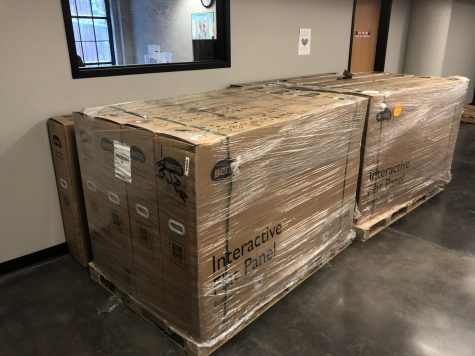
Ten BenQ boards sit outside of the nurses office. Though only three boards were for GCAA, Confluence had them all delivered to one location to save on shipping costs.
“The reason that they were all delivered here is that they charged four hundred dollars per delivery site, and so it was cost efficient to have them all delivered to one school. And then the folks installing them will just move them to the schools they’re going to internally,” executive director of curriculum and assessment Louise Losos said.
Out of the ten boards received, three were installed into the rooms of high school English teacher Dana Chamberlain, high school science teacher Bradford Buck and middle school math teacher Deanna Breeden during the third week of school. The rest were distributed to the other Confluence schools.
“So there are a couple things going on in this building, not everyone has a smartboard. You have some people who have a projector and a whiteboard, I think there are some actual smart boards that have a projector and then an interactive whiteboard…the BenQ looks like a really big TV screen, but there’s no projector. So it’s all in one and can be run hopefully, wirelessly through the teacher’s computer so it allows them more flexibility in the classroom…Marcy Dotson, who is our instructional technology coordinator, she did the research on it and found that the cost of a BenQ was basically the same or maybe a smidge more than the cost for the projector and the installation of the projector…it’s about an equivalent cost but it’s a better product for the teacher,” Losos said.
According to the BenQ website, “Studies show that, after integrating flipped classrooms into K-12 education, 67% of teachers saw a perceivable increase in test scores and 80% reported their students’ attitude towards subjects also significantly improved. BenQ’s educational technology, including ultra short throw projectors and interactive flat panels, is aimed to cultivate a student-centered K-12 classroom, allowing young students to expand their knowledge via touch-enhanced interactive learning.” The specific BenQ model that our school has received, the RM6501K’s, has low blue light technology and flicker-free technology, while low blue light reduces blue light exposure and allows for healthier time spent in front of a display, flicker-free technology takes out LED backlight flickering to reduce CVS-related eye problems and alleviates discomfort which is caused by looking at the screen all day. The BenQ model we received also includes anti-glare, wireless connectivity for simple collaboration, and a handwriting processing feature allowing presenters to convert written text, forms, numbers, and drawings into legible materials.
When asked about the BenQ boards, none of the principles, head of school, or administrators within the school, could answer questions on where the money was coming from to fund the BenQs, where they were going within the school building, or how many we were receiving.
“So the head of school was hired a week before school started, if you think about it, so there’s just a lot that, you know, you can’t bring up to speed on every aspect of every decision made. For the principles…with all that was going on, conversations were ongoing, I think they just forgot about them…they were the ones that selected what classrooms they go into, the principals did, we didn’t say it’s going here or here, the principles are asked where do you think they should be placed, so they made that call,” Losos said.
Though school officials declined to state the price paid for the boards, nor did they identify their vendor, the model of the BenQ boards purchased by Confluence retails for just over $2500 each from B&H Photo. In comparison, the InFocus brand projectors that are in use in most classrooms run between $850-$1000.
“We have a district-wide technology budget, which covers things like teachers computers and Chromebooks, projectors, document cameras and any piece of equipment has a lifespan,” Losos said, “Rather than replace [the projectors in classrooms], it is more cost-effective and a better experience for student and teachers to put in the BenQs.”
The BenQ comes with a lot of new interactive and classroom themed technology, that will be a new experience for both teachers, students, and the school.
“I think that the flexibility of not being tethered is a tremendous bonus, plus you don’t have to worry about bulbs going out,” Losos said, “We’re hoping that this will be a positive experience for both teachers and students because they’re also interactive so kids can get up and do stuff.”
As the BenQs are currently being installed teachers have yet to be taught how to use them or incorporate them into the curriculum.
“We have three instructional technology teachers in the district, Ms. Dotson is one of them. A woman by the name of Melba Goliday is the instructional technology teacher here, so when we install then we also do some training with the teacher here,” Losos said.
While teachers are learning how to use their new BenQ boards, Reeder said, “I would tell them to be patient and have a backup plan. Because the lessons don’t always work out the way you want to at first, so if you hit technical snags you kind of have to have a backup, And still do your lesson while you’re learning how to use the board. And to stick with it, it can get frustrating sometimes when you don’t know how to use it.”
Your donation will support the student journalists of Grand Center Arts Academy. Your contribution will allow us to purchase equipment and cover our annual website hosting costs.


